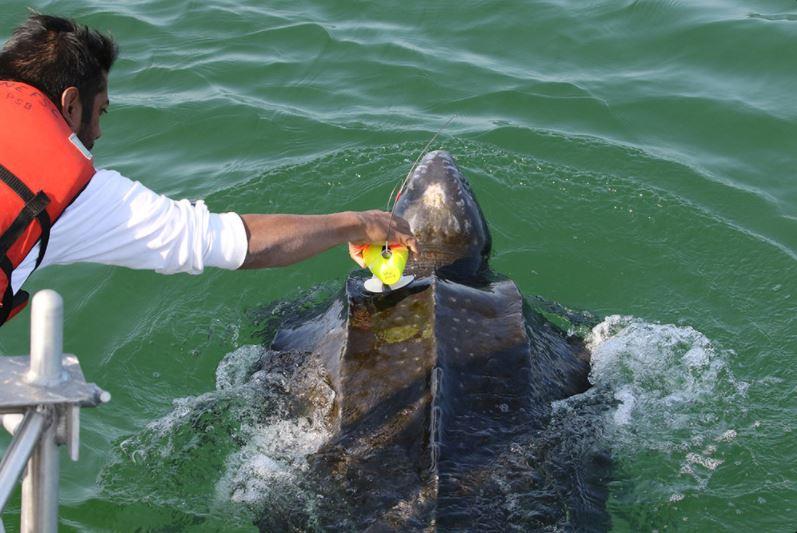
Collaboration and innovation key in turtle research
by NOAA Fisheries 21 Dec 2017 18:51 UTC

Samir Patel from Coonamessett Farm Foundation places a re-usable suction-cup tag from DFO Canada on a leatherback turtle in Cape Cod Bay during a September 2017 test run. Permit #16556 © NOAA Fisheries / Heather Haas, NEFSC
The proverb "necessity is the mother of invention" could not be more true for many scientists, among them sea turtle researcher Heather Haas of the Northeast Fisheries Science Center's (NEFSC's) Woods Hole Laboratory.
With limited funds available for turtle projects, Haas is collaborating with colleagues in Canada, Florida, North Carolina, and Massachusetts to find innovative ways to stretch the budget and accomplish the mission.
"We can accomplish far more by working together than if we each went our own way," Haas said of the effort. In May she traveled to North Carolina to work with staff from the Southeast Fisheries Science Center (SEFSC). The team first needed to assess leatherback turtle abundance and behavior and see if it was feasible to capture the turtles with small boats. Leatherback turtles congregate in coastal waters of North Carolina for a few days in May each year before continuing their migration in open waters. Leatherbacks are the largest sea turtle, reaching lengths up to eight feet and weighing up to 2,000 pounds.
Haas and colleagues have been studying loggerhead turtles for years, using satellite tags to track their movements and behavior as part of the Atlantic Marine Assessment for Protected Species program, but the hurdles associated with leatherback sampling required a new game plan.
"Studying leatherbacks is different from our loggerhead research as they require the presence of a veterinarian, are much larger animals, and they can be ephemeral," Haas said. "You don't know when and where they will appear or for how long, so we need to have boats available on short notice. We'd like to move some of our capture operations from large vessels to NOAA's small boats, but it can be tricky to deal with a thousand-pound animal in a 26-foot boat."
Based on their initial scouting trip in May, Haas and SEFSC colleagues Chris Sasso, Larisa Avens, Joanne Braun McNeill, and Annie Gorgone developed a leatherback capture and tagging method using NOAA's existing small boat fleet, rather than using larger, more expensive ships. Charter vessels also have limited scheduling flexibility, making it hard to select good weather days for research needs.
Project partners Mike James of the Department of Fisheries and Oceans (DFO) in Canada and Sasso had observed that actively migrating leatherbacks can be tough to capture if they are swimming more than eating. Luckily, however, the North Carolina leatherbacks were spending time at the surface and allowed close approaches with the sampling boat.
In September a prototype of a high resolution suction cup tag, developed by DFO and partners in Halifax, Nova Scotia, was tested on a leatherback in Cape Cod Bay. The tag was deployed overnight, collecting information on foraging and the animal's behavior. Once the tag falls off, it is retrieved and the data recovered for analysis.
In October the team did a test-run of their new system in Cape Cod Bay. Using two small boats outfitted with bow pulpits and observation platforms and a third small open-bow boat proved perfect for getting a leatherback turtle aboard between the two boats for research and tagging before it is released back to the water. Sasso had an open-bow inflatable boat custom-built that easily held the netted leatherback and a few scientists.
In the NEFSC boat were Haas, Lisa Conger, Michael Ball and Leah Crowe from NEFSC and Samir Patel from the Coonamessett Farm Foundation in Falmouth, Mass. In the SEFSC boat were Sasso, Avens and Gorgone from the SEFSC, Mike James from DFO, and veterinarian Craig Harms from North Carolina State University.
Waters around Cape Cod can be easily accessed from the NEFSC's Woods Hole Laboratory, and in North Carolina easy access to coastal waters is available from the SEFSC's Beaufort Laboratory.
Another multi-partner project is now underway to study leatherbacks using small boats. Coonamessett Farm Foundation has applied for and received a Saltonstall-Kennedy grant to look at fishing gear interactions with leatherbacks. Co-researchers are Haas, Henry Milliken and Eric Matzen from the NEFSC, DFO, The Leatherback Trust, Cape Cod Commercial Fishermen's Alliance, and Marine Imaging Technologies.
This year's pilot work is laying the foundation for a busy field season in 2018. Improvements to the tags are being made over the winter to make them longer-lasting, smarter and more useful to researchers. In May the team plans to work on tagging those ephemeral North Carolina leatherbacks. As part of NOAA Fisheries Bycatch Reduction Engineering Program, the team plans to leave tags on the turtles for up to three days to learn more about how the turtles interact with the environment and with fishing gear to develop better strategies for mitigating entanglement risks. And as part of continued work with the AMAPPS program, the researchers will work to place some satellite tags on leatherbacks. Those tags should stay in place for months.
Haas looks forward to collaboration and continued work with Fisheries and Oceans Canada, where there is a large leatherback population. She began working with Canadian colleagues in 2015 on loggerheads and that research expanded to leatherbacks. Since then she has continued to collaborate with other turtle researchers and has funded or supported a number of novel research techniques, including using an underwater vehicle to track and film sea turtles.